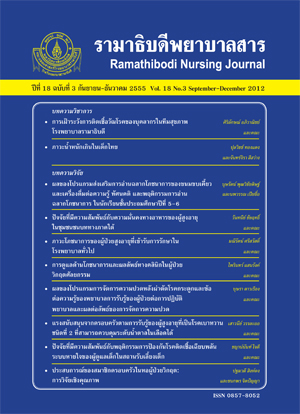ภาวะโภชนาการของผู้ป่วยสูงอายุที่เข้ารับการรักษาในโรงพยาบาลทั่วไป
Main Article Content
Abstract
บทคัดย่อ
โครงสร้างประชากรไทยกำลังเปลี่ยนแปลงในทางที่กลุ่มผู้สูงอายุมีสัดส่วนเพิ่มขึ้น เป็นกลุ่ม ที่มีปัญหาสุขภาพและเจ็บป่วยกันมาก เป็นสัดส่วนหลักของผู้ป่วยในโรงพยาบาล และเป็นผู้ที่มี ปัญหาทุพโภชนาการ ซึ่งส่งผลเสียต่อสุขภาพและผลลัพธ์การรักษา การได้รับการคัดกรองภาวะ โภชนาการตั้งแต่แรกรับและการประเมินภาวะโภชนาการ เป็นการเริ่มต้นที่สำคัญของการดูแล ด้านโภชนาการในผู้ป่วย การวิจัยเชิงบรรยายครั้งนี้มีวัตถุประสงค์เพื่อศึกษาภาวะโภชนาการและ ความเสี่ยงทางโภชนาการของผู้ป่วยสูงอายุที่เข้ารับการรักษาในแผนกอายุรกรรม ศัลยกรรม และ ศัลยกรรมกระดูกและข้อ โรงพยาบาลสมเด็จพระพุทธเลิศหล้า จังหวัดสมุทรสงคราม จำนวน 265 ราย เลือกตัวอย่างแบบเจาะจงตามคุณสมบัติที่กำหนด เก็บข้อมูลตามแบบบันทึกข้อมูล ส่วนบุคคล และแบบประเมินความเสี่ยงทางโภชนาการสำหรับคนไทย ภาวะโภชนาการประเมิน จากดัชนีความหนาของร่างกาย เส้นรอบเอว สัดส่วนเส้นรอบเอวต่อรอบสะโพก ฮีโมโกลบิน ฮีมาโตคริท อัลบูมินในเลือด และจำนวนเม็ดเลือดลิมโฟไซท์ ผลการศึกษาพบว่า เมื่อแรกรับเข้า ไว้รักษาในโรงพยาบาล ผู้ป่วยสูงอายุร้อยละ 76.2 มีความเสี่ยงทางโภชนาการ มีนํ้าหนักเกินและ อ้วนร้อยละ 45.7 และนํ้าหนักน้อยร้อยละ 8.8 มีภาวะอ้วนลงพุงร้อยละ 91.7 ประมาณ 1 ใน 3 มีภาวะโลหิตจาง (ฮีโมโกลบินตํ่าร้อยละ 33.6 และฮีมาโตคริทตํ่าร้อยละ 33.9) จำนวนเม็ดเลือด ชนิดลิมโฟซัยท์ทั้งหมดตํ่าร้อยละ 25.6 และมีภาวะขาดโปรตีนคือ ค่าอัลบูมินในเลือดตํ่าร้อยละ 32.4 เมื่อเปรียบเทียบนํ้าหนัก ดัชนีความหนาของร่างกาย เส้นรอบเอว และสัดส่วนเส้นรอบเอว ต่อรอบสะโพกวันที่ 7 ของการรักษาในโรงพยาบาลและก่อนจำหน่าย มีค่าเฉลี่ยน้อยกว่าแรกรับ อย่างมีนัยสำคัญทางสถิติ ก่อนจำหน่ายจากโรงพยาบาลมีภาวะโลหิตจางน้อยลง แต่มีภาวะโปรตีน ตํ่ามากขึ้น กว่าแรกรับเข้ารักษาในโรงพยาบาลอย่างมีนัยสำคัญทางสถิติ ผู้ป่วย 202 ราย (ร้อยละ 85.2) มีนํ้าหนักลดลงขณะรับการรักษาในโรงพยาบาล ตั้งแต่ 0.5 ถึง 6 กิโลกรัม จากการศึกษา ครั้งนี้พบว่า ผู้ป่วยสูงอายุมีความเสี่ยงต่อภาวะทุพโภชนาการตั้งแต่แรกรับมากกว่าครึ่งหนึ่ง หาก พบว่าผู้ป่วยสูงอายุรายใดมีความเสี่ยง พยาบาลควรให้การดูแลเรื่องโภชนาการเป็นพิเศษ
คำสำคัญ: ภาวะโภชนาการ ผู้ป่วยสูงอายุ ความเสี่ยงทางโภชนาการ โรงพยาบาล
Abstract
The structure of Thai population has been changed due to a higher proportion of older population. The elderly patients are the predominant group in the hospital as they generally had health problems and illness, especially malnutrition, which has a negative influence on health and outcomes. Nutritional risk classification (NRC) at the first time of hospital admission and nutritional assessment are essential principal of nutritional care in patients. The aim of this descriptive research was to describe nutritional status and nutritional risk in 265 older patients admitted to medical, surgical, and orthopaedic units of Somdetphaphutthalertla Hospital in Samutsongkram Province. The patients were recruited according to the inclusion criteria. The data was collected in the Personal Record Form and Thai Nutrition Risk Classification (Thai NRC) Form. Nutritional status was assessed using body mass index (BMI), waist circumferences, and waist-hip ratios (WHR), hemoglobin and hematocrit levels, serum albumin levels, and total lymphocyte counts (TLC). The result showed that at the first time of hospital admission, 76.2% of the older patients had nutritional risk; 45.7% were over weight and obesity; 8.8% were underweight; 91.7% had abdominal obesity, a onethird of sample had anemia (low hemoglobin = 33.6% and low hematocrit = 33.9%), low total lymphocyte counts = 25.6% and protein undernutrition (low serum albumin = 32.4%). The means of body weights, body mass index, waist circumferences, and waist-hip ratios at the seventh day of hospital admission and at discharge were significantly lower than those at admission. At discharge the patients had mild anemia, but had significantly lower protein status; 202 patients (85.2%) had loss body weights (0.5-6 kg) during hospital admission. In this study, more than half of the older patients were classified as at risk to malnutrition at the time of hospital admission. Nurse should particularly provide nutritional care for older patients with malnutrition risk.
Keywords: Nutritional status, Older patients, Nutritional risk, Hospital
Article Details
บทความ ข้อมูล เนื้อหา รูปภาพ ฯลฯ ที่ได้รับการตีพิมพ์ในรามาธิบดีพยาบาลสาร ถือเป็นลิขสิทธิ์ของวารสาร หากบุคคลหรือหน่วยงานใดต้องการนำทั้งหมดหรือส่วนหนึ่งส่วนใดไปเผยแพร่หรือเพื่อกระทำการใด ใด จะต้องได้รับอนุญาตเป็นลายลักษณ์อักษรจากรามาธิบดีพยาบาลสารก่อนเท่านั้น


